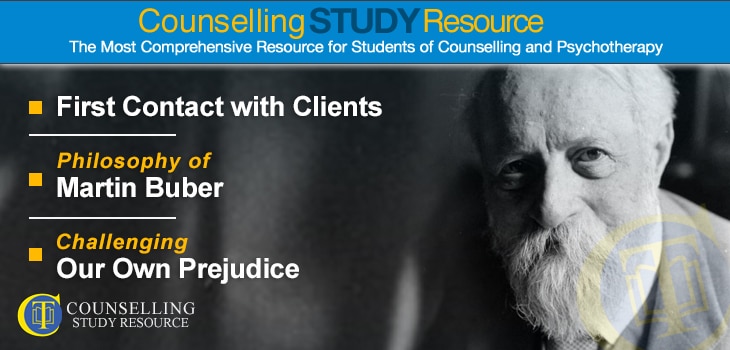062 – First Contact with Clients – Philosophy of Martin Buber – Challenging Our Own Prejudice
In episode 62 of the Counselling Tutor Podcast, Ken Kelly and Rory Lees-Oakes offer tips on how to make the first contact with a new client. ‘Theory with Rory’ summarises Martin Buber’s concept of ‘I–Thou’ versus ‘I-It’. Last, the presenters discuss the difficulties of seeing our own areas of prejudice.
First Contact with Clients (starts at 2.32 mins)
What do you say in the very first telephone contact with a new client? While some agencies have staff who will do this for you, other agencies require counsellors to contact clients themselves after initial assessment to arrange the first appointment.
Ken and Rory offer some useful tips on this:
- Remember that the client will have been expecting your phone call.
- Try to choose a quiet place to make the call.
- Use an agency phone rather than your own, unless you can be sure you can stop your number from showing.
- Check that the assessment/referral notes to see whether the client has stated which times/days are best for them to receive a phone call.
- Start off by giving your name and role, and checking with the client that it is a convenient time to speak.
- You have not yet contracted with the client, and this is a transactional conversation rather than a counselling session, so try not to let the client open up too much about their difficulties at this stage. You could say something like: ‘I hear that you’re carrying a lot; maybe we could talk about this in the session.’
- Explain to the client that the number you have called from is not monitored all the time, so that they know it is not a suitable port of call in a crisis.
Philosophy of Martin Buber (starts at 14.40 mins)
Martin Buber was an anthropological philosopher who was born in Vienna in 1878. His idea about the difference between I–Thou and I–It relationships relate to the difference between the medical and social models of mental health.
Buber strongly influenced Carl Rogers, who was concerned with building and sustaining meaningful relationships in therapy. Buber’s book Ich und Du (since translated into English as I and Thou) was first published in 1923. In an I–It relationship, one human is the passive recipient of the other’s influence or control (for example, a patient receiving a traditional medical diagnosis). In an I–Thou relationship, meanwhile, the communication is truly human-to-human and equality-based (e.g. when a counsellor establishes a meaningful connection with a client).
Challenging Our Own Prejudice (starts at 17.50 mins)
How can we identify and challenge our own personal prejudices? Every human has prejudices and if we believe we don’t, it’s because they may be invisible to us. Indeed, true prejudice is the one we do not see, acting out of a set of beliefs we hold as the truth but that in fact marginalise or downplay someone else.
Personal development is key here, perhaps supported by personal counselling. Clinical supervision is also invaluable in spotting prejudice in relationships with clients.


